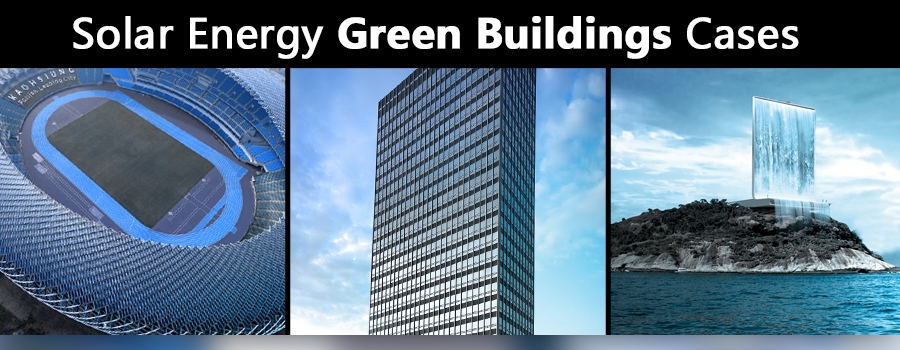With global warming, it is increasingly recognized that carbon dioxide generated by the use of energy in buildings is a major source of warming. Energy-efficient buildings have become an inevitable trend in building development, and green buildings have emerged. As a new type of building model, solar energy green building perfectly combines solar energy technology and green building concept, injecting new vitality into the construction industry. This blog will introduce the concept of solar energy green building and globally recognized green buildings.
The What, Why and How of Solar Energy Green Buildings
What is a solar energy green building?
The so-called green building, simply put, is a building constructed with environmental awareness, which protects the environment, reduces pollution, and provides people with a healthy, applicable and efficient use of space. A solar energy green building, as the name suggests, is a building that utilizes photovoltaic panels, solar hot water systems, and other equipment to achieve energy self-sufficiency and reduce consumption and environmental pollution.
Solar energy green buildings achieve these goals through a number of features. First, they use highly efficient thermal insulation systems, including high-quality window, door and wall materials, as well as precise seals and valves, to ensure that heat stays inside the room during the cold winter and outside on hot summer days. Second, solar energy green buildings use solar technology to generate electricity and hot water, including solar collectors and storage systems. This technology reduces reliance on traditional non-renewable capacity.

Why build a solar energy green building?
- Energy saving and environmental protection: Solar energy green building fully utilizes solar energy, reduces dependence on traditional energy sources, and lowers energy consumption and carbon emissions. Compared to traditional buildings, it can save up to 50% or more energy.
- Economic benefits: Although the initial investment in solar energy equipment is high, the solar energy system will bring continuous energy-saving benefits to the building over time. It is estimated that the payback period for a photovoltaic system that can meet the needs of an entire building is typically 5-10 years, and its lifespan can reach 30-70 years.
- Improvement of living comfort: Through rational building design, the solar energy green building realizes natural ventilation, lighting and heat preservation, and improves living comfort. At the same time, the solar hot water system can also fulfill the daily life needs for the residents.
How to design a solar green building?
- Building location and orientation: When selecting a site for a green building, it is necessary to examine how much sunlight hits the surface of the solar panel array at that location during the day, which is closely related to the amount of power generated by the photovoltaic system. Designs such as sunrooms and skylights can be used to maximize the use of solar energy.
- Allocate available space: Where can the solar panels be placed? Is there space on the roof, on the ground or in the carport? If placed on the roof, can the building structurally support the weight of the panel array? How to choose the right solar panel? These are all elements that need to be emphasized in the design.
- Choice of building materials: Resource consumption and environmental pollution can be reduced through the use of renewable, recyclable and low carbon emission materials. At the same time, it is necessary to optimize the building structure and thermal insulation design, such as setting up green plants on the roof to lower the temperature, to achieve the purpose of reducing energy consumption and improving energy-saving performance.
Solar Energy Green Building Cases

Kaohsiung, China: National Stadium
Designed by Japanese architect Toyo Ito. This is a dragon themed stadium, with a steel reinforced structure that looks like layers of scales from the outside.
The entire facade of this stadium is basically covered by solar panels and the interior features solar cells with a power of up to 1 MW. The stadium uses a total of 8,844 solar panels to supply electricity, which are enough to power 3,300 lights and 2 giant displays. Not only can the stadium meet its needs, but it can also send excess electricity to other areas of Taiwan, reducing carbon dioxide emissions by 660 tons per year.
Manchester, UK: CIS Tower
Designed by designers Gordon Tait and GS Hay for the Co-operative Insurance Society (CIS). The building was completed in 1962, more than 60 years ago. The main body of the building is a standard rectangular shape of reinforced concrete with metal frames and glass curtain walling, which is a typical international style building.
CIS commissioned Arup in 2004 to replace the deteriorating mosaics on the building's surface with 575.5 kW of integrated photovoltaic (PV) cells, which generate 180,000 kWh of electricity per year. This initiative has made it one of the most internationally recognized super-solar buildings.
Rio de Janeiro, Brazil: Solar City Tower
Designed by RAFAA for the 2016 Olympic Games in Rio de Janeiro. The Solar City Tower was designed to combine renewable energy with architectural aesthetics to demonstrate Brazil's commitment to sustainable development.
The project includes a solar power station that will power the Olympic village and city during the day and pump excess energy into the tower in the form of seawater; at night, the seawater will be released and can drive a turbine to generate electricity again. When the water pours down, it creates a grand and spectacular waterfall, which is one of the most unique charms of the building.
The common feature of these green buildings is that they all make full use of solar energy technology, reducing traditional energy consumption and improving energy efficiency and sustainability through other technologies. As a green energy source promoted by governments, solar energy has great potential for development. With the continuous advancement of technology, more solar-powered green buildings will emerge globally in the future. If you're wondering how to power your own green home, visit PowerHome to shop for great green energy generation equipment at great prices.
(1).png)
(1).png)